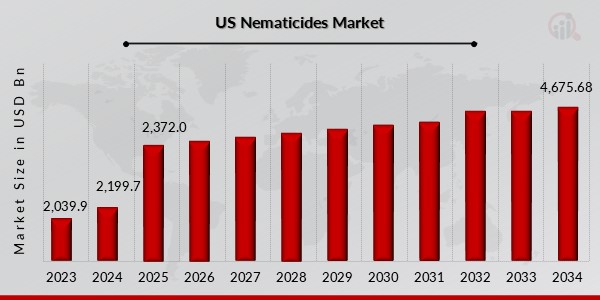US Nematicides Market Outlook
US Nematicides Market Size was valued at USD 2,199.72 million in 2024. US Nematicides industry is projected to grow from USD 2,372.0 million in 2025 to USD 4,675.68 million by 2034, exhibiting a compound annual growth rate (CAGR) of 7.8% during the forecast period (2025 - 2034).

Battling Below the Surface: An Analysis of the US Nematicide Market Invisible enemies lurk beneath the fertile soils of American agriculture: nematodes. These microscopic worms wreak havoc on crops, inflicting billions of dollars in damage annually. The US nematicide market, worth billions itself, serves as the frontline defense against this hidden threat.
A Spectrum of Foes:
Nematodes encompass a diverse array of adversaries, each with its own vulnerabilities and predilections. Root-knot nematodes, infamous for their gall-inducing abilities, plague a wide range of crops, from vegetables to cotton. Cyst nematodes, with their armored cysts, target specific hosts like soybean and potatoes. Reniform nematodes, notorious for their resilience, pose a particular challenge to cotton and tobacco growers. Understanding these nuances is crucial for selecting the most effective nematicide solution.
Demand Driven by Damage:
The demand for nematicides is directly tied to the economic ramifications of nematode infestations. Yield losses, quality declines, and increased input costs are the bitter fruits of unchecked nematode populations. Crops like vegetables, with their high market value and susceptibility to nematode damage, drive significant demand for these pest control agents. Additionally, rising awareness of nematode threats, fueled by agricultural extension services and industry research, has further bolstered market demand.
Chemical Cavalry: The Traditional Arsenal:
Chemical nematicides remain the workhorses of the market, with organophosphates and carbamates accounting for a significant share. These potent chemicals offer broad-spectrum control, eradicating diverse nematode species. However, concerns regarding environmental impact and human health risks associated with some chemicals have spurred a shift towards alternative solutions.
Biological Brigade: A Greener Approach:
The rise of bio-based nematicides marks a growing trend towards sustainable pest control. Bacteria, fungi, and other naturally occurring organisms are harnessed to target specific nematodes, minimizing impact on beneficial soil microbes and environmental health. While currently holding a smaller market share than chemical options, bio-based nematicides are experiencing rapid growth, fueled by regulatory pressure and consumer demand for eco-friendly solutions.
Seed Treatment Takes Root:
The application method also plays a crucial role in market dynamics. Seed treatment, where nematicides are coated onto seeds before planting, has gained popularity for its convenience and targeted delivery. This method minimizes environmental exposure and offers long-lasting protection against early-stage nematode infestations. However, soil application remains prevalent for established crop infestations and specific nematode types.
Shared Spoils: A Landscape in Play:
The US nematicide market is a competitive battlefield, with multinational giants like BASF, Bayer, and Dow AgroSciences jostling for dominance. Smaller players, specializing in bio-based solutions or niche applications, carve out their own territories. Acquisitions and strategic partnerships are on the rise, as companies seek to expand their portfolios and reach a wider audience. The market remains in flux, with innovative technologies and changing regulatory landscapes likely to reshape the competitive landscape in the years to come.
The US nematicide market is a microcosm of the larger agricultural battle against invisible threats. As awareness of nematode damage increases and regulations evolve, the demand for effective and sustainable solutions will continue to drive market growth. The future of this market lies in a blend of potent chemical options, emerging bio-based alternatives, and targeted application methods, all focused on safeguarding the future of American agriculture.
| Report Attribute/Metric |
Details |
| Market Size 2024 |
USD 2,199.72 Million |
| Market Size 2025 |
USD 2,372.00 Million |
| Market Size 2034 |
USD 4,675.68 Million |
| Compound Annual Growth Rate (CAGR) |
7.8% (2025-2034) |
| Base Year |
2022 |
| Forecast Period |
2025-2034 |
| Historical Data |
2019-2023 |
| Forecast Units |
Value (USD Million) |
| Report Coverage |
Revenue Forecast, Competitive Landscape, Growth Factors, and Trends |
| Segments Covered |
Type, Form, Crop Type, Mode of Application, and Region |
| Geographies Covered |
North America, Europe, Asia Pacific, R, and the Rest of the World |
| Countries Covered |
The U.S, Canada, Mexico, the UK, France, Germany, Italy, Spain, China, India, Japan, Australia and New Zealand, South America, the Middle East, and Africa |
| Key Companies Profiled |
BASF SE (Germany), Bayer AG (Germany), Syngenta AG (Switzerland), UPL Ltd. (India), Ishihara Sangyo Kaisha Ltd.(ISK) (Japan), Valent BioSciences LLC (U.S.), Simbiose Agrotecnologia Biologica (Brazil), Profarm (U.S.), American Vanguard Corporation (U.S.), Certis (U.S.) |
| Key Market Opportunities |
· Technological developments and rising investment in R&D activities |
| Key Market Dynamics |
· Strategic Merger and Acquisition |
Frequently Asked Questions (FAQ) :
The US Nematicides Market is expected to be valued at 308.0 million USD in 2024.
By 2035, the US Nematicides Market is projected to reach a value of 715.0 million USD.
The forecasted CAGR for the US Nematicides Market from 2025 to 2035 is approximately 7.957%.
Fumigants are expected to dominate the market with a projected value of 280.0 million USD by 2035.
The market size for Carbamates is expected to grow to 160.0 million USD by 2035.
Key players include Nippon Soda, FMC Corporation, Sumitomo Chemical, and BASF among others.
The US Nematicides Market for Organophosphates is expected to reach 200.0 million USD by 2035.
The market for 'Others' type nematicides is projected to be valued at 75.0 million USD by 2035.
Growth drivers include increasing agricultural production and rising awareness about crop protection.
Global agricultural trends and innovations significantly influence the growth and development of the US Nematicides Market.














